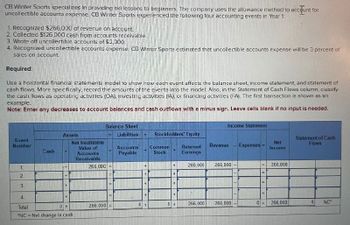
FINANCIAL ACCOUNTING
10th Edition
ISBN: 9781259964947
Author: Libby
Publisher: MCG
expand_more
expand_more
format_list_bulleted
Question
None

Transcribed Image Text:CB Winter Sports specializes in providing ski lessons to beginners. The company uses the allowance method to account for
uncollectible accounts expense. CB Winter Sports experienced the following four accounting events in Year 1:
1. Recognized $266,000 of revenue on account.
2. Collected $126,000 cash from accounts receivable
3. Wrote off uncollectible accounts of $2,300.
4. Recognized uncollectible accounts expense. CB Winter Sports estimated that uncollectible accounts expense will be 3 percent of
sales on account.
Required:
Use a horizontal financial statements model to show how each event affects the balance sheet, income statement, and statement of
cash flows. More specifically, record the amounts of the events into the model. Also, in the Statement of Cash Flows column, classify
the cash flows as operating activities (OA), investing activities (IA), or financing activities (FA). The first transaction is shown as an
example.
Note: Enter any decreases to account balances and cash outflows with a minus sign. Leave cells blank if no input is needed.
Balance Sheet
Liabilities
Income Statement
Assets
Event
Number
Net Realizable
Cash
Value of
Accounts
Receivable
1.
2.
3.
4
Total
+
0+
"NC Net change in cash
Stockholders' Equity
Accounts
Payable
Common
Stock
Retained
Earnings
Revenue
Expenses =
Net
Income
Statement of Cash
Flows
266,000
+
266,000
266,000
266,000
266,000
E
0+
266,000
266,000
0 =
266,000
NC
Expert Solution
This question has been solved!
Explore an expertly crafted, step-by-step solution for a thorough understanding of key concepts.
This is a popular solution
Trending nowThis is a popular solution!
Step by stepSolved in 2 steps

Knowledge Booster
Similar questions
arrow_back_ios
arrow_forward_ios
Recommended textbooks for you

 AccountingAccountingISBN:9781337272094Author:WARREN, Carl S., Reeve, James M., Duchac, Jonathan E.Publisher:Cengage Learning,
AccountingAccountingISBN:9781337272094Author:WARREN, Carl S., Reeve, James M., Duchac, Jonathan E.Publisher:Cengage Learning, Accounting Information SystemsAccountingISBN:9781337619202Author:Hall, James A.Publisher:Cengage Learning,
Accounting Information SystemsAccountingISBN:9781337619202Author:Hall, James A.Publisher:Cengage Learning, Horngren's Cost Accounting: A Managerial Emphasis...AccountingISBN:9780134475585Author:Srikant M. Datar, Madhav V. RajanPublisher:PEARSON
Horngren's Cost Accounting: A Managerial Emphasis...AccountingISBN:9780134475585Author:Srikant M. Datar, Madhav V. RajanPublisher:PEARSON Intermediate AccountingAccountingISBN:9781259722660Author:J. David Spiceland, Mark W. Nelson, Wayne M ThomasPublisher:McGraw-Hill Education
Intermediate AccountingAccountingISBN:9781259722660Author:J. David Spiceland, Mark W. Nelson, Wayne M ThomasPublisher:McGraw-Hill Education Financial and Managerial AccountingAccountingISBN:9781259726705Author:John J Wild, Ken W. Shaw, Barbara Chiappetta Fundamental Accounting PrinciplesPublisher:McGraw-Hill Education
Financial and Managerial AccountingAccountingISBN:9781259726705Author:John J Wild, Ken W. Shaw, Barbara Chiappetta Fundamental Accounting PrinciplesPublisher:McGraw-Hill Education


Accounting
Accounting
ISBN:9781337272094
Author:WARREN, Carl S., Reeve, James M., Duchac, Jonathan E.
Publisher:Cengage Learning,

Accounting Information Systems
Accounting
ISBN:9781337619202
Author:Hall, James A.
Publisher:Cengage Learning,

Horngren's Cost Accounting: A Managerial Emphasis...
Accounting
ISBN:9780134475585
Author:Srikant M. Datar, Madhav V. Rajan
Publisher:PEARSON

Intermediate Accounting
Accounting
ISBN:9781259722660
Author:J. David Spiceland, Mark W. Nelson, Wayne M Thomas
Publisher:McGraw-Hill Education

Financial and Managerial Accounting
Accounting
ISBN:9781259726705
Author:John J Wild, Ken W. Shaw, Barbara Chiappetta Fundamental Accounting Principles
Publisher:McGraw-Hill Education